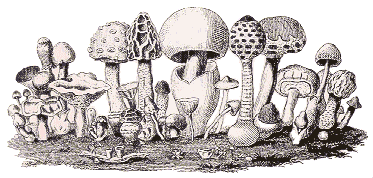On a recent field trip to Rivington we spent some time in oak woodland. We saw most of the species mentioned below on the trees and on recently fallen branches. We see only the fruiting structures, and the dynamics of the system are hidden from our view. The following explanation for their presence is taken from a study based on the collection of oak branches in south-west England (Boddy & Rayner (1983) ). The species lists for other species of tree will differ, as explained below.
The study is based on analysis of cross section of branches collected. Fungal individuals, of one or more species, occupy separate volumes of the branch, whose extent is revealed by sectioning the branch at intervals along its length, and identifying the occupants of the zones found. This is achieved by culturing these. It is possible with experience to identify some species by the appearance of the zone and its perimeter.
The four most commonly observed species of attached oak branches are all pioneer species, capable of invading living wood, and therefore forming interfaces with living wood, but not too effective at combat, therefore reaching deadlock at interfaces with other species in the same branch. (Secondary invaders enter wood already rotted, and so do not have interfaces with living wood, but overcome and progressively replace pioneer species at the interface with the pioneer).
- Stereum gausapatum Causes white rot, but does not attack the bark.
- Vuilleminia comedens Causes white rot. While not attacking the bark the fruitbody defoliates the outer layer of that tissue.
- Peniophora quercina Mainly attacks the ends of the branches.
- Exidia glandulosa Causes death of the bark.
- Phellinus ferreus A pioneer species causing white rot.
- Phlebia rufa A pioneer causing white rot in weak branches, e.g. lower branches weakened by low light intensity.
- Hyphoderma setigerum Always associated with insect boring, causing bark loss.
- Coriolus (Trametes) versicolor Very aggressive.
- Phlebia radiata Causing bark loss, associated with insect damage.
- Peniophora lycii More commonly found on beech. Believed to be favoured by dry conditions, therefore at more of an advantage with thin-barked trees such as beech.
- Stereum hirsutum Rare on attached branches, and then only invading small terminal branchlets. As Coriolus versicolor, much more common on fallen wood.
- Schizophora paradoxa Similar to Hyphoderma setigerum, in causing bark loss in association with insect damage.
These pioneer species are often seen to be associated with heartwood wings in the cross section, thought to be produced prematurely by the living wood in response to attack. Some defence is achieved thereby.
The following three species are locally abundant:
The following secondary invaders are occasionally found. They are able to replace the pioneer species:
Less commonly found:
Footnotes
The pioneer species tend to favour, or even to be restricted to, a particular species or genus of tree. Presumably a degree of specialisation is necessary to overcome the defences of the tree. The secondary invaders need only to overcome the pioneer invaders and thus have less preference for particular tree species.
When the attached branch becomes detached and falls to the ground it becomes available to other fungi such as the cord-forming species, but this is another scene.
All the species mentioned above have been recorded in north-west England, but Phellinus ferreus, Phlebia rufa and Hyphoderma setigerum are least often seen. There seems no reason to suspect that our more northerly location much affects the fungal community described here.
Photographs of 10 of the 12 species mentioned are to be found in Phillips (1985), but Hyphoderma setigerum and Phlebia rufa in Breitenbach & Kränzlin (1986).
Lynn Boddy and Alan Rayner have published a great deal of research work on many aspects of the ecology of wood decay.
References
Boddy L. & Rayner A.D.M. (1983) 'Ecological roles of basidiomycetes in attached oak branches' New Phytologist 93 77-88
Breitenbach J. & Kränzlin F. (1986) 'Fungi of Switzerland' vol. 2. Mykologia.
Phillips R. (1985) 'Mushrooms and other fungi of Great Britain & Europe' Pan.
